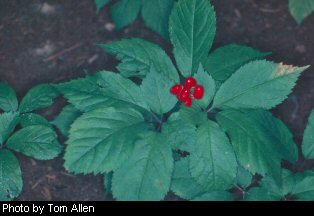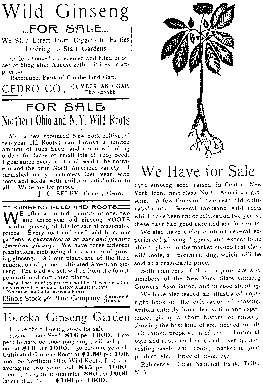

Notice:Ginseng Seasons start date has Changed to September 1st of each year. The History, the Mystery of GinsengBy Emily Grafton When I first became interested in botany in the early 1970s, discovering a patch of wild ginseng in a shady mountain cove was a thrill. As a young college student, I listened with awe at the legends of curative powers associated with this plant. During that period, a local herbalist spoke each year to botany students providing a novel history lesson on ginseng's medicinal properties. But serious botanists and medical professionals scoffed that ginseng was anything more than snake oil.
Today, herbalists and physicians in the western world use ginseng to treat everything from fatigue to hypertension. Its most widely accepted and well-documented use is tied to its adaptogenic effects--its ability to enhance the body's overall resistance to physical stress. This may include everything from increasing one's stamina to withstanding cold temperatures. When ginseng is taken in large quantities however, it can cause hypertension. In low doses, it is reasonably safe for healthy adults. Despite all the research, obviously, more needs to be done. It is uncertain when the first pre-historic human experimented with Chinese ginseng ( Panax panax ) , but the first written Chinese Herbal (encyclopedia of medicinal plants) appeared in the first century AD. The Shen-nung pen-ts'ao-ching stated that ginseng or “ schinseng ” could boost longevity and increase one's endurance. The text stated that it was good for “enlightening the mind, and increasing the wisdom. Continuous use leads one to longevity.” Chinese herbalists also believed that ginseng functioned as an aphrodisiac. No doubt, this attribute led to an even higher demand for the product. The expression schinseng meant “essence of the earth in the form of man .” This poetic title relates to the human-like form of the root of the genus Panax . Ancient cultures on all continents independently evolved the belief that the shapes of plants or plant parts were a clue to their curative powers. The Panax root is shaped like the human form, thus its use as a cure-all or panacea for the whole body. In the west this philosophy was formally called the Doctrine of Signatures. Publication of the Chinese Herbal popularized the use of the plant and this knowledge spread rapidly throughout northern China. Powerful lords and eventually the centralized government soon controlled regions of ginseng habitat. The plant became as precious as gold, and massive armies fought for control of ginseng territories. By the sixth century wild Chinese ginseng had become scarce. American ginseng ( Panax quinquefolius ) was used by native Americans for similar purposes, but was not accorded any special status. In 1714, a Canadian Jesuit named Father Lafitau received a dried plant of Chinese ginseng from a colleague, Father Jartoux . Working in China, Father Jartoux asked his Canadian counterpart to see if it grew in the New World. Father Lafitau discovered The Chinese revered American ginseng and the wild ginseng business mushroomed throughout the 18th and 19th centuries. Thomas Jefferson listed it in his inventory of native plant resources. Daniel Boone supplemented his income by digging ginseng. An all- time record of 750,000 pounds of ginseng root was shipped from the United States to China in 1824. By the late 1800s, the plant was no longer abundant. Though native populations have continued to diminish since those early days, wild ginseng is still harvested from the eastern United States where it occurs naturally from Maine to Georgia. In the 2000-2001 season, 8,600 pounds of wild ginseng were dug from the West Virginia hills for commercial sale. The average selling price was about $300 per pound. According to Robin Black, a forester with the West Virginia Division of Forestry, West Virginia still has lots of wild ginseng. In fact, populations may have received a reprieve over the last decade. According to Black, “Fewer people are digging now than in the past.” In some states, however, populations have been seriously decimated. The U.S. Fish & Wildlife Service passed a law requiring that plants must be five years or older to be harvested. Counting the leaf scars on the rhizome at the base of the stem allows one to easily detect the age of a ginseng plant. The stem rises from a bud that grows at the top of the root. When the stem dies back in the fall it leaves behind a leaf scar. A ginseng root actually shrinks as the bud develops. This consequent shrinking and growing produces wrinkles on the neck of the root. These wrinkles or leaf scars may be counted to estimate a plant's age. Young ginseng plants will produce one or two leaves. After about three or four years, a ginseng plant will produce three to six leaves divided into five lobed leaflets. The leaves are arranged in a whorl around a central axis. Also, after three to four years, ginseng plants begin to produce flowers. Multiple tiny, green flowers arise from the center of the umbrella-shaped leaf arrangement in late May or early June. Anyone who wants to successfully harvest ginseng every year must learn to estimate the age of a plant before harvesting it. The older a plant is, the more convoluted the root will become and the more closely it will resemble the human form. Because of beliefs established over 2000 years ago, those older plants bring a higher price. To this day, it is still a delight to find this ancient healer revered for thousands of years in the shadowy forests of the Mountain State. Emily Grafton was formerly the WildYards coordinator for the DNR.
|
 Since those college days decades ago, the usefulness of ginseng in American culture has swayed with changes in medical philosophy, though herbalists never entirely discarded it. A new wave in acceptance of ginseng and other herbal medicines surfaced in the 1980s with ginseng showing up on the shelves of health food stores and even in relatively mainstream Celestial Seasonings tea. Many studies have been conducted to ascertain the healing attributes of ginseng, but despite all the research, controversy still surrounds authenticity of its attributes.
Since those college days decades ago, the usefulness of ginseng in American culture has swayed with changes in medical philosophy, though herbalists never entirely discarded it. A new wave in acceptance of ginseng and other herbal medicines surfaced in the 1980s with ginseng showing up on the shelves of health food stores and even in relatively mainstream Celestial Seasonings tea. Many studies have been conducted to ascertain the healing attributes of ginseng, but despite all the research, controversy still surrounds authenticity of its attributes.  American ginseng and shipped several pounds to China where the Jesuits received $5 per pound.
American ginseng and shipped several pounds to China where the Jesuits received $5 per pound.